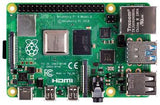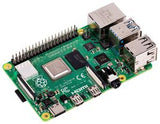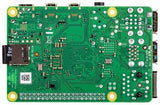Note: This product does not qualify for free shipping and all Raspberry Pi products are non-refundable.
Completely upgraded, re-engineered
Faster, more powerful
You'll recognize the basic shape and size, so you can simply drop your new Raspberry Pi into your old projects for an upgrade; and as always, we've kept all our software backwards-compatible, so what you create on a Raspberry Pi 4 will work on any older models you own too.
Overview
Raspberry Pi 4 Model B is the latest product in the popular Raspberry Pi range of computers. It offers ground-breaking increases in processor speed, multimedia performance, memory, and connectivity compared to the prior-generation Raspberry Pi 3 Model B+, while retaining backwards compatibility and similar power consumption. For the end user, Raspberry Pi 4 Model B provides desktop performance comparable to entry-level x86 PC systems.
This product’s key features include a high-performance 64-bit quad-core processor, dual-display support at resolutions up to 4K via a pair of micro-HDMI ports, hardware video decode at up to 4Kp60, 2GB of RAM, dual-band 2.4/5.0 GHz wireless LAN, Bluetooth 5.0, Gigabit Ethernet, USB 3.0, and PoE capability (via a separate PoE HAT add-on).
The dual-band wireless LAN and Bluetooth have modular compliance certification, allowing the board to be designed into end products with significantly reduced compliance testing, improving both cost and time to market.
Not sure which Raspberry Pi 4 RAM size you have?
More Raspberry Pi 4 and Bundle
| Raspberry Pi 4 Model B 2GB RAM | 16GB microSD Bundle | |
| Raspberry Pi 4 Model B 4GB RAM | 16GB microSD Bundle | 32GB microSD Bundle |
| Raspberry Pi 4 Model B 8GB RAM | 16GB microSD Bundle |
Specifications
- Broadcom BCM2711, quad-core Cortex-A72 (ARM v8) 64-bit SoC @ 1.5GHz
- 8GB LPDDR4 SDRAM
- 2.4 GHz and 5.0 GHz IEEE 802.11b/g/n/ac wireless LAN, Bluetooth 5.0, BLE
- True Gigabit Ethernet
- 2 x USB 3.0 ports, 2 x USB 2.0 Ports
- Fully backwards compatible 40-pin GPIO header
- 2 x micro HDMI ports supporting up to 4K 60Hz video resolution
- 2-lane MIPI DSI/CSI ports for camera and display
- 4-pole stereo audio and composite video port
- MicroSD card slot for loading operating system and data storage
- Requires 5.1V, 3A power via USB-C or GPIO
- PoE (Power over Ethernet) enabled (requires PoE HAT)
Documents
- Raspberry Pi 4 Model B product brief
- Raspberry Pi 4 Model B schematic diagrams
- Raspberry Pi 4 Model B mechanical drawing
- Documentation including hardware and configuration
Software & OS
Beginners should start with the NOOBS (New Out Of Box Software) operating system installation manager, which gives the user a choice of operating system from the standard distributions.
SD cards with NOOBS pre-installed should be available from any of our global distributors and resellers. Alternatively, you can download NOOBS.
Raspbian is the recommended operating system for normal use on a Raspberry Pi.
Find help with installing Raspbian on your Pi in our online Getting started guide.
You can browse basic examples to help you get started with some of the software available in Raspbian, find more detail about the Raspbian operating system, or read information on fundamental Linux usage and commands for navigating the Raspberry Pi and managing its file system and users.













